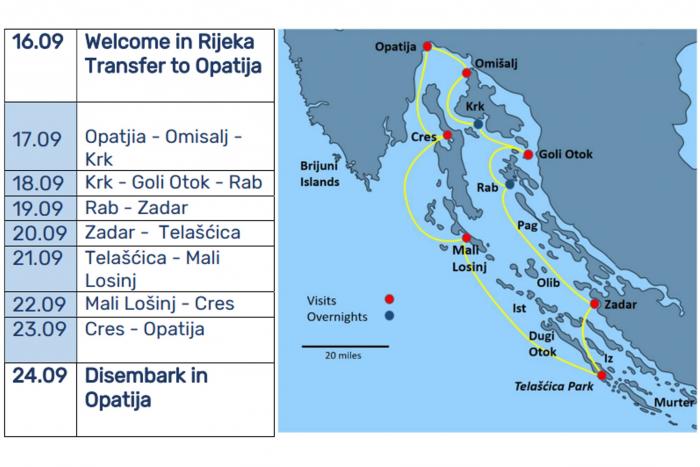
WaterScapes in Heritage and Environment deals with the interplay between Historical, Cultural and Natural Heritage.
WaterScapes most innovative feature is Navigation. The boat becomes the working and living space for one entire week for 20 international participants.
WaterScapes is articulated in seminars on board and visits on land. Main focuses of the scientific program are:
Coordinators: Elena Bougleux UniBG – Sanja Iguman IFDT
in cooperation with
University of Rijeka – PhD Program and Delta Lab
Univeristy of Belgrade – IFDT
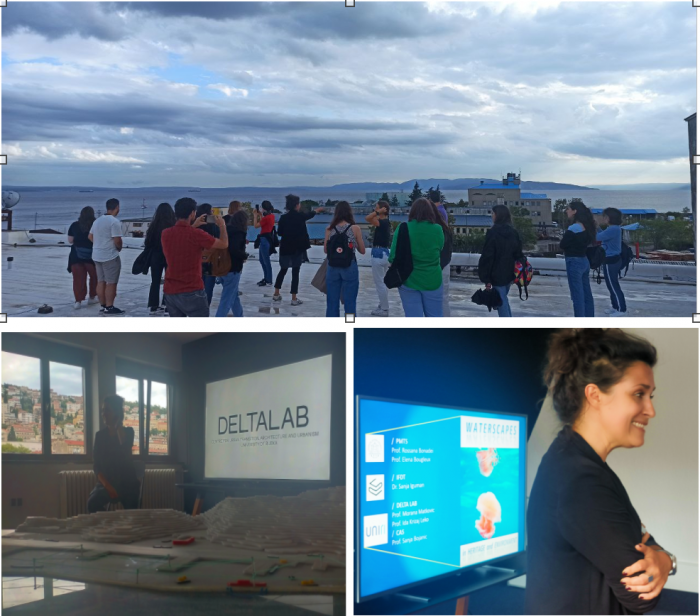
WaterScapes took its first steps on the mainland starting on the roof !
We met our partners from Deltalab, and Morana Matković presented the projects and activities they are carrying out in Rijeka.
DeltaLab works on urban regeneration through research, training, design and planning of urban interventions.
Their methodology is grounded in interdisciplinary research and collaboration, networking, and creativity, as well as a critical consideration of both established and novel architectural and urban norms, producing a resilient and sustainable (spatial) future.
find more on https://deltalab.hr/
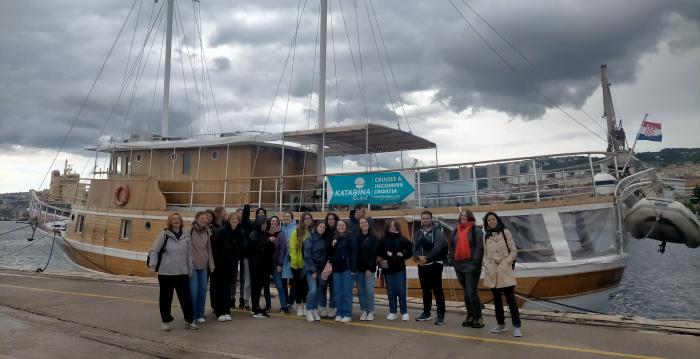
WaterScapes started with the first lecture: Rossana Bonadei, from UniBg, took us on a fascinating journey through Seascapes in Narratives and Imaginaries.
At lunchtime we finally boarded our Dalmatinka, which was waiting for us on Rijeka's Molo Longo.
Then… the wind and rain forced WaterScapes into a small change of plan, but unpredictability is exactly one of the frames in which the anthropocene manifests itself and in which we must learn to live and operate.
In the afternoon we were unable to sail due to Bura as planned, therefore, we remain on board and we listened to Morana Causevic-Bully, archeologist from the University of Bourgogne Franche-Comtè who presented the Fulfinum Mirine Archaeological Park.
Morana Causevic-Bully explained the intertwining between archaeological research in this site and the ongoing battle to defend it from the expansion of industrial sites around it.
In Omisalj Bay, the remains of an early Christian church from the 5th century A.D. are surrounded by recent gas storage facilities and by abandoned industrial remains. The defence of the environment becomes coupled with the recognition and valorisation of the archaeological heritage.
Morana's words also narrated how, along with protection, becoming heritage entails a series of dilemmas, as strategic choices that will affect the future of places and the people living around them.
Becoming heritage means opening up to new flows of resources and new people; it is a particular 'growth' that would certainly have multiple but potentially contradictory effects on residents and the environment.
These are the dilemmas we have to face, building a vision allowing places like this to become heritage guaranteeing lasting and sustainable growth for people and the environment.

This morning at dawn WaterScapes finally started sailing and we had our first sailing lecture by Stefan Guzvica from IFDT .
Stephan Guzvica introduced us to the historical site of Goli Otok, the Bald Island.
On this island, in the early years after World War II, Tito's socialist government interned several thousand political opponents, mainly people considered loyal to the Soviet Union and Stalin's positions. The Goli Otok concentration camp was thus born and developed within the conflict between Stalinism and Tito's socialism. Today, all that remains of the facilities where thousands of people were imprisoned are the ruins, because seventy years after that historical phase, neither the memory of Tito's Yugoslavia nor Stalinism are the subject of interest of administrations or civil society. The memory of that historical moment, as well as the remnants of the structures of the Goli Otok camp, end up as an empty and abandoned heritage, where commercial and tourist initiatives are haphazardly superimposed.
What can be the future of this site, of this island and its history?
How can it speak to the present and become common heritage?
But sailing, the lecture and the visit were only the first part of the day.
During the afternoon navigation, the students carried out a group activity. Together with Stephan they worked on possible forms of presentation and tourist enhancement of the site of Goli Otok.
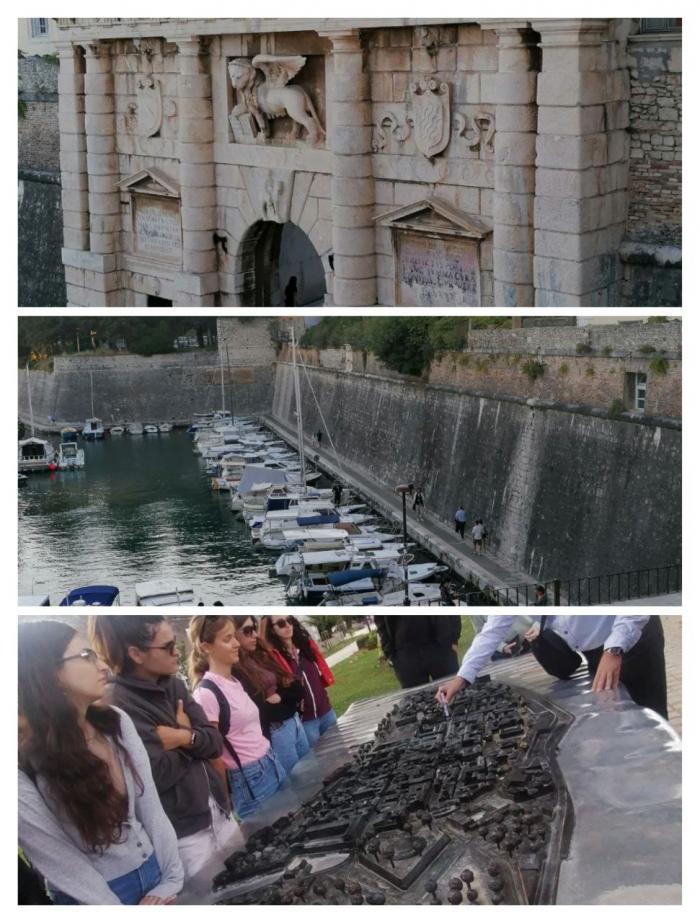
On monday morning WaterScapes sailed to Zadar facing some rain and a slightly rough sea. We were surrounded by low, grey clouds, which hinted at thunderstorms in the distance, but our three hour sail was barely wet and definitely peaceful.
Zadar, on the other hand, welcomed us with clear skies and a warm, bright sun!
The first lecture of the day was given by Jelena Zlatar Gamberožić and Anđelina Svirčić Gotovac from the Institute for Social Research Zagreb.
Anđelina Svirčić Gotovac proposed the concept of litorialisation to understand the demographic, social and economic transformations of Croatia in recent decades. The increase in tourist flows and the wealth they generate has progressively moved quotas of population and political attention towards the coast, with the consequence of emptying the country's inland areas, including internal areas of the islands. The consequences also affect the coastal areas, where housing and services are almost entirely oriented towards tourism and its economy. Croatia's rapprochement with the EU has strengthened these processes, both legally and logistically. Today, the environmental and economic crises have highlighted the risks of a growth model centred exclusively on tourism and on one single type of tourist flow.
Anđelina Svirčić Gotovac proposal is to recover vocations and activities from the past, starting from food production and handicrafts. These knowledge and practices can be useful to build a new economic and cultural balance, based on the mixture of different economic activities and identities. Local societies themselves can develop a new view to sustainability based.
Jelena Zlatar Gamberožić presented her research about three villages and tourist destinations on the island of Brač. She highlighted the effects of different political choices taken at local level, in terms of urban development and land management. Jelena emphasised the importance of involving local communities in the decision making processes about tourism development, on whether and how to intensify tourist flows and facilities. But the ongoing lack of communication and reciprocal trust between citizens and institutions has made the involvement impossible, at least so far.
In the afternoon and evening were dedicated to a tour of Zadar. Tomislav Fabijanic from Zadar University guided us to discover the city's rich historical heritage, where remains from the Roman and Venetian periods are physically overlapping. For some years now, Zadar has been the site of a UNESCO heritage transnational network project, and thanks to this initiative numerous connections have developed, particularly with Bergamo. The similarities of architecture and urban planning concepts in both cities are amazing.
Tomislav Fabijanic has told us about a new big urbanistic project that foresees the construction of one more marina along the Riva, in the very center of the old city; a marina dedicated to large cruise ships that would significantly reduce the actual pedestrian and green zone. This project has stirred up a social controversy that is still ongoing, in which citizens and local organisations oppose yet another large infrastructure that aims to increase the number of tourists, even at the price of further reducing the space and services dedicated to the city's already few residents. The Riva in center Zadar has already undergone major landscape transformations, with the intervention of contemporary artists and their permanent light and sound installations.
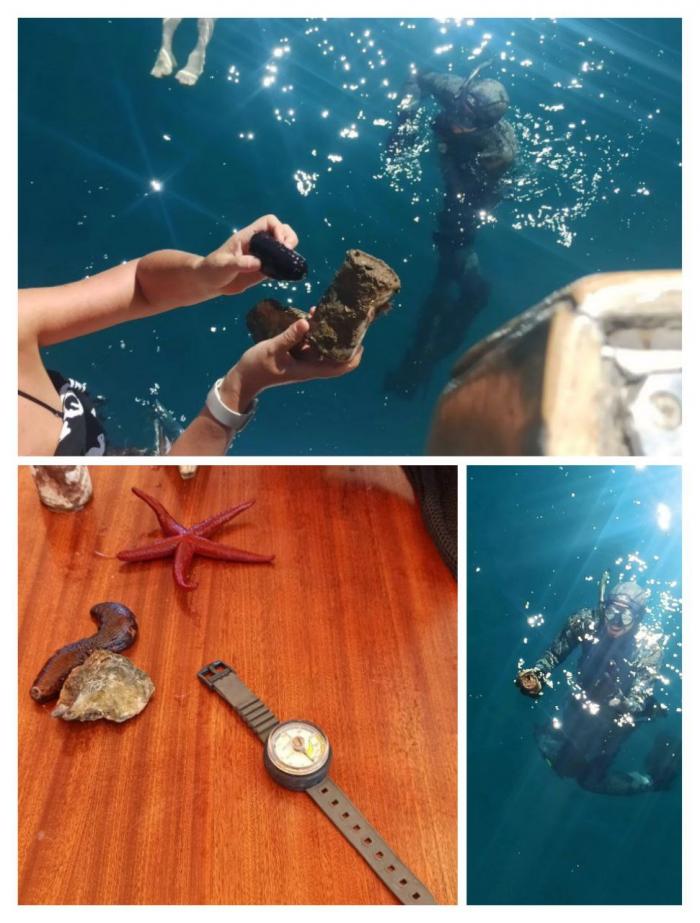
On tuesday morning WaterScapes entered in the Telašćica regional park through a 20 meters passage with only 4 meters depth, could you imagine having a lecture in this breathtaking environment? It happened today, our professor Elena Bougleux decided to move the lesson to the bow of the boat so that we could learn while enjoy this unique waterscape.
Following, we had a visit of Telascica Nature Park one of the areas where institutional intervention has limited and modified tourist flows and ensured protection for terrestrial and marine ecosystems. The visit was prepared with a WaterTalk with Stefan Andjus, hydrobiologist from the IBISS Institute, University of Belgrade, who spoke to us about biodiversity below the sea surface...but it was not only a talk: Stefan Andjus dived into water with his equipment and explored the seabed. He brought us a few marine forms of life and he showed us the (beauties and the) complexities of marine environment.
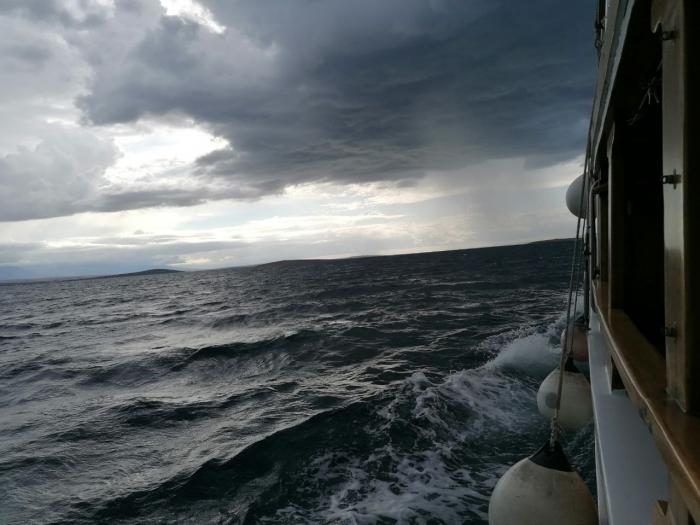
The marvelous cliffs of Telašćica, on the southern tip of Dugi Otok, served as a stunning backdrop for Sanja Iguman's lecture this morning. The scholar provided an historic overview on the emergence and development of tourism on the Adriatic Coast.
This phenomenon started in the first half of the XIX century when aristocrats from the Austro-Hungarian empire travelled there for leisure and producing literary works inspired by the place. Then in the XX century, especially after the Second World War, Croatia was pushed as a mass tourism destination, favoured by the rising of more affordable facilities and means of travelling (such as cars and planes). The 90s wars in former Yugoslavia put a temporary stop to tourism, but later on, thanks to low cost carriers, mass tourism could flourish once again, now making Croatia one of the prime destinations of the Mediterranean Sea, with all the changes and criticisms for environment and demography we could see in these days.
After arriving in the port of Malj Lošinj we welcomed on board Nika Zoričić from University of Bergamo who gave a lecture on Alberto Fortis’ Travels. Fortis published Journey to Dalmatia in 1774. At the time the text was contested by other authors for its inaccuracies, but today scholars agree on the fact that this text played an important role in introducing the Dalmatian culture to Europe creating a romantic imaginario on its people and places.
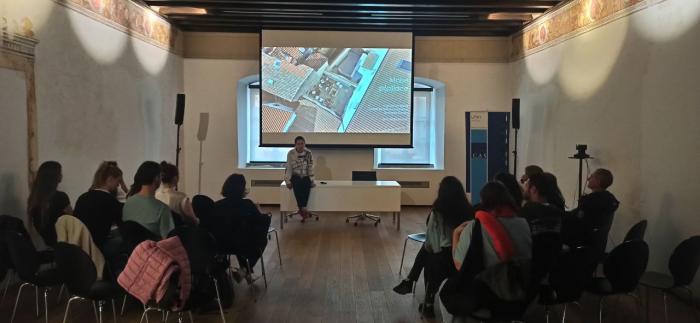
Today WaterScapes reached the island of Cres. Here we met again with Sanja Bojanić from the University of Rjieka, with whom we visited the Moise Palace and learned about its history and architectural features.
The Moise Palace is registered as a cultural heritage of the Republic of Croatia, and the City of Cres together with the University of Rijeka agreed to work together on long-term maintenance and management of cultural values.
The challenge is to give this historical heritage a future, that is to be able to preserve its unique architectural characteristics and at the same time implement activities that make it a living place.
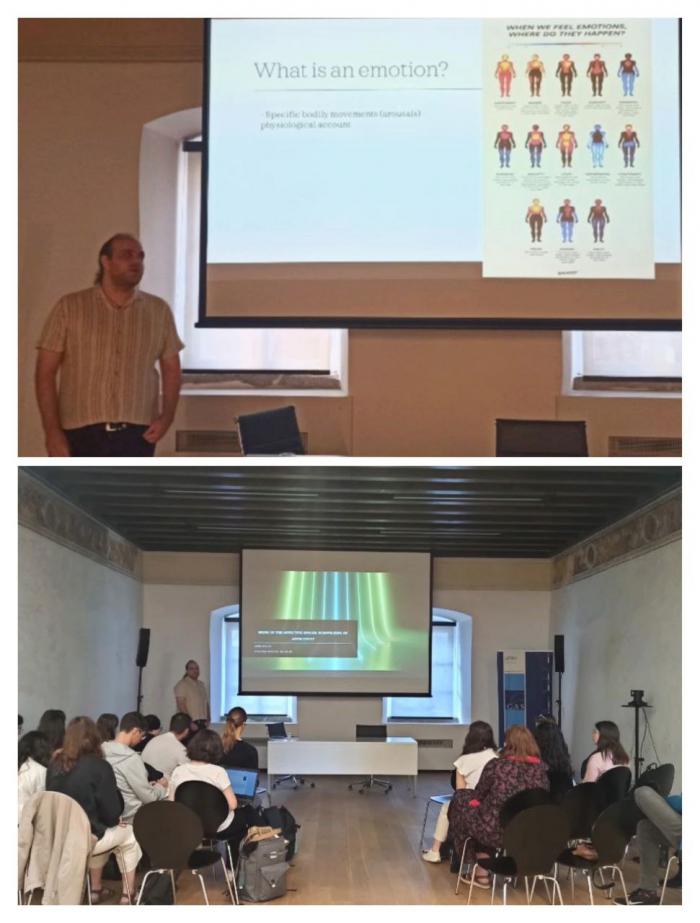
While docked in Cres, today WaterScapes moved once more to the Moise Palace, where we met Igor Cvejić, from IFDT Uni Belgrade .
In his lecture Igor explored the connections between places and emotions, a pivotal topic for thinking tourism and environment.
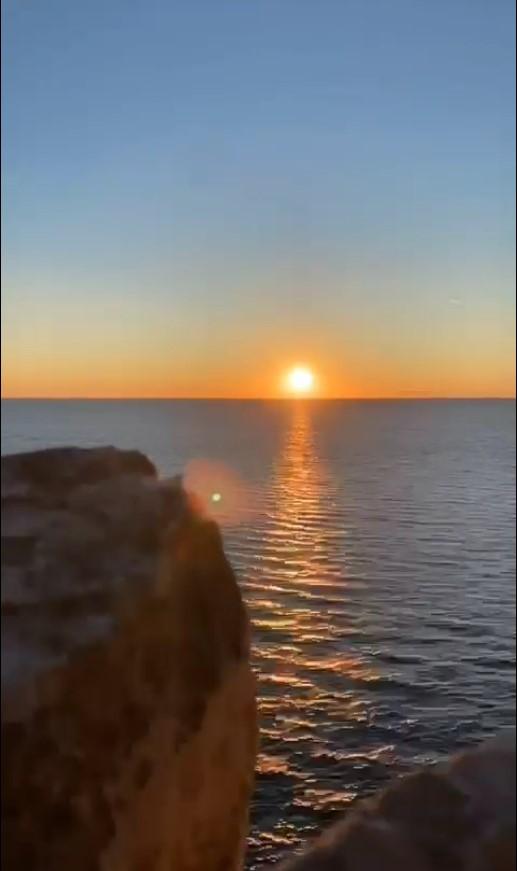
WaterScapes has come to its conclusion.
We packed our bags, said goodbye to Dalmatinka and are now on our way to our homes on the mainland.
There have been lessons, visits, talks and activities.
There have been days of sailing together, and the challenges (and hardships) of being close to each other and finding harmony.
There have been days of encounters and discoveries.
Above all, there were days in which, starting from our unstable position in the water and from the sea, we were able to glimpse and imagine new connections between places, stories, people and ideas,
Now that it is over, we know that WaterScapes was a first journey along which we tried to learn how to imagine the future